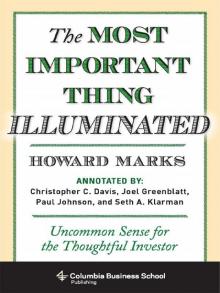- Home
- Howard Marks
The Most Important Thing Illuminated Page 4
The Most Important Thing Illuminated Read online
Page 4
I’ll turn to the latter first, since I don’t believe in it and should be able to dispose of it rather promptly. Technical analysis, or the study of past stock price behavior, has been practiced ever since I joined the industry (and well before that), but it’s been in decline. Today observations about historic price patterns may be used to supplement fundamental analysis, but we hear far less than we did in the past about people basing decisions primarily on what price movements tell them.
Part of the decline of technical analysis can be attributed to the random walk hypothesis, a component of the Chicago theory developed in the early 1960s, primarily by Professor Eugene Fama. The random walk hypothesis says a stock’s past price movements are of absolutely no help in predicting future movements. In other words, it’s a random process, like tossing a coin. We all know that even if a coin has come up heads ten times in a row, the probability of heads on the next throw is still fifty-fifty. Likewise, the hypothesis says, the fact that a stock’s price has risen for the last ten days tells you nothing about what it will do tomorrow.
Another form of relying on past stock price movements to tell you something is so-called momentum investing. It, too, exists in contravention of the random walk hypothesis. I’m unlikely to do it justice. But as I see it, investors who practice this approach operate under the assumption that they can tell when something that has been rising will continue to rise.
Momentum investing might enable you to participate in a bull market that continues upward, but I see a lot of drawbacks. One is based on economist Herb Stein’s wry observation that “if something cannot go on forever, it will stop.” What happens to momentum investors then? How will this approach help them sell in time to avoid a decline? And what will it have them do in falling markets?
It seems clear that momentum investing isn’t a cerebral approach to investing. The greatest example came in 1998–1999, with the rise of people called day traders. Most were nonprofessional investors drawn from other walks of life by the hope for easy money in the tech-media-telecom stock boom. They rarely held positions overnight, since doing so would require them to pay for them. Several times a day, they would try to guess whether a stock they’d been watching would rise or fall in the next few hours.
I’ve never understood how people reach conclusions like these. I liken it to trying to guess whether the next person to come around the corner will be male or female. The way I see it, day traders considered themselves successful if they bought a stock at $10 and sold at $11, bought it back the next week at $24 and sold at $25, and bought it a week later at $39 and sold at $40. If you can’t see the flaw in this—that the trader made $3 in a stock that appreciated by $30—you probably shouldn’t read the rest of this book.
Moving away from momentum investors and their Ouija boards, along with all other forms of investing that eschew intelligent analysis, we are left with two approaches, both driven by fundamentals: value investing and growth investing. In a nutshell, value investors aim to come up with a security’s current intrinsic value and buy when the price is lower, and growth investors try to find securities whose value will increase rapidly in the future.
To value investors, an asset isn’t an ephemeral concept you invest in because you think it’s attractive (or think others will find it attractive). It’s a tangible object that should have an intrinsic value capable of being ascertained, and if it can be bought below its intrinsic value, you might consider doing so. Thus, intelligent investing has to be built on estimates of intrinsic value. Those estimates must be derived rigorously, based on all of the available information.
“THE MOST IMPORTANT THING,” JULY 1, 2003
JOEL GREENBLATT: This estimate of value includes an estimate for future growth in earnings or cash flow.
What is it that makes a security—or the underlying company—valuable? There are lots of candidates: financial resources, management, factories, retail outlets, patents, human resources, brand names, growth potential and, most of all, the ability to generate earnings and cash flow. In fact, most analytical approaches would say that all those other characteristics—financial resources, management, factories, retail outlets, patents, human resources, brand names and growth potential—are valuable precisely because they can translate eventually into earnings and cash flow.
The emphasis in value investing is on tangible factors like hard assets and cash flows. Intangibles like talent, popular fashions and long-term growth potential are given less weight. Certain strains of value investing focus exclusively on hard assets. There’s even something called “net-net investing,” in which people buy when the total market value of a company’s stock is less than the amount by which the company’s current assets—such as cash, receivables and inventories—exceed its total liabilities. In this case, in theory, you could buy all the stock, liquidate the current assets, pay off the debts, and end up with the business and some cash. Pocket cash equal to your cost, and with more left over you’ll have paid “less than nothing” for the business.
The quest in value investing is for cheapness. Value investors typically look at financial metrics such as earnings, cash flow, dividends, hard assets and enterprise value and emphasize buying cheap on these bases. The primary goal of value investors, then, is to quantify the company’s current value and buy its securities when they can do so cheaply.
Growth investing lies somewhere between the dull plodding of value investing and the adrenaline charge of momentum investing. Its goal is to identify companies with bright futures. That means by definition that there’s less emphasis on the company’s current attributes and more on its potential.
The difference between the two principal schools of investing can be boiled down to this:
• Value investors buy stocks (even those whose intrinsic value may show little growth in the future) out of conviction that the current value is high relative to the current price.
• Growth investors buy stocks (even those whose current value is low relative to their current price) because they believe the value will grow fast enough in the future to produce substantial appreciation.
Thus, it seems to me, the choice isn’t really between value and growth, but between value today and value tomorrow. Growth investing represents a bet on company performance that may or may not materialize in the future, while value investing is based primarily on analysis of a company’s current worth.
“THE HAPPY MEDIUM,” JULY 21, 2004
JOEL GREENBLATT: One of Buffett’s major contributions has been to extend the idea of value beyond the simply “cheap.” Buffett looks for “good” businesses that are available at an attractive price. The concept of growth is incorporated into the calculation of value.
It would be convenient to say that adherence to value investing permits investors to avoid conjecture about the future and that growth investing consists only of conjecture about the future, but that would be a considerable exaggeration. After all, establishing the current value of a business requires an opinion regarding its future, and that in turn must take into account the likely macro-economic environment, competitive developments and technological advances. Even a promising net-net investment can be doomed if the company’s assets are squandered on money-losing operations or unwise acquisitions.
There’s no bright-line distinction between value and growth; both require us to deal with the future. Value investors think about the company’s potential for growth, and the “growth at a reasonable price” school pays explicit homage to value. It’s all a matter of degree. However, I think it can fairly be said that growth investing is about the future, whereas value investing emphasizes current-day considerations but can’t escape dealing with the future.
For an extreme example of growth investing, let me take you back to the days of the Nifty Fifty, a fad that epitomized the contrast with value investing and demonstrates how far a growth mania can go.
In 1968 I had my first job in the investment management industry, as a summer employee
in the Investment Research Department of First National City Bank (now Citibank). The bank followed an approach known as “Nifty Fifty investing.” Its goal was to identify the companies with the brightest outlook for earnings growth over the long term. In addition to growth rate, the bank’s investment managers stressed “quality,” by which they meant a high probability that the growth expectations would be realized. It was official dictum that if a company was growing fast enough and of sufficient quality, the price paid for the stock didn’t matter. If a stock is expensive based on today’s metrics, give it a few years and it’ll grow into its price.
Then, as now, growth stock portfolios were heavily weighted toward drugs, technology and consumer products. The bank’s portfolios included highly respected names such as IBM, Xerox, Kodak, Polaroid, Merck, Eli Lilly, Avon, Coca-Cola, Philip Morris, Hewlett-Packard, Motorola, Texas Instruments and Perkin-Elmer—America’s great companies, all with bright outlooks for growth. Since nothing could go wrong at these companies, there was no hesitance to pay up for their stocks.
Fast-forward a couple of decades, and what do you see in that list of companies? Some, such as Kodak and Polaroid, have seen their basic businesses decimated by unforeseen changes in technology. Others, such as IBM and Xerox, became slow-moving prey on which new competitors feasted. All told, First National City’s list of America’s best companies has been visited by deterioration and even bankruptcy in the forty-two years since I started. So much for the long-term persistence of growth—and for the ability to predict it accurately.
CHRISTOPHER DAVIS: Interestingly, this portfolio—if purchased in 1968 and held until today—eventually beat the market, but it took decades to get out of the hole and succeeded only because of the tremendous outperformance of Philip Morris. Although the principle is correct (that overpaying destroys returns) this example is also a reminder of the difference between stocks and bonds. Because stocks represent ownership interests in businesses that have essentially unlimited duration; if you are right about the business, time can reduce the cost of overpaying. In some rare cases (like Philip Morris) it is possible to benefit from the “miracle” of compounding at double-digit rates for more than forty years. As far as I know, this opportunity has never been available in fixed-income investment.
Compared to value investing, growth investing centers around trying for big winners. If big winners weren’t in the offing, why put up with the uncertainty entailed in guessing at the future? There’s no question about it: it’s harder to see the future than the present. Thus, the batting average for growth investors should be lower, but the payoff for doing it well might be higher. The return for correctly predicting which companies will come up with the best new drug, most powerful computer or best-selling movies should be substantial.
In general, the upside potential for being right about growth is more dramatic, and the upside potential for being right about value is more consistent. Value is my approach. In my book, consistency trumps drama.
If value investing has the potential to consistently produce favorable results, does that mean it’s easy? No.
For one thing, it depends on an accurate estimate of value. Without that, any hope for consistent success as an investor is just that: hope. Without accurate estimates, you’ll be as likely to overpay as to underpay. And if you overpay, it takes a surprising improvement in value, a strong market or an even less discriminating buyer (what we used to call a “greater fool”) to bail you out.
There’s more. If you’ve settled on the value approach to investing and come up with an intrinsic value for a security or asset, the next important thing is to hold it firmly. That’s because in the world of investing, being correct about something isn’t at all synonymous with being proved correct right away.
It’s hard to consistently do the right thing as an investor. But it’s impossible to consistently do the right thing at the right time. The most we value investors can hope for is to be right about an asset’s value and buy when it’s available for less.
SETH KLARMAN: Ideally, considerably less. The bigger the discount, the bigger your margin of safety. Too small a discount and the limited margin of safety provides no real protection at all.
But doing so today certainly doesn’t mean you’re going to start making money tomorrow.
JOEL GREENBLATT: I always tell my students, “If you do a good job valuing a stock, I guarantee that the market will agree with you.” I just don’t tell them when. It could be weeks or years. Graham said that the market is a “weighing machine” over the long term, even if it is often emotional over the short term. In my experience with the U.S. stock markets, two or three years is generally enough time for the market to get it “right.” If you read the newspaper every day, this is often a tougher wait than it sounds.
A firmly held view on value can help you cope with this disconnect.
Let’s say you figure out that something’s worth 80 and have a chance to buy it for 60. Chances to buy well below actual value don’t come along every day, and you should welcome them. Warren Buffett describes them as “buying dollars for fifty cents.” So you buy it and you feel you’ve done a good thing.
But don’t expect immediate success. In fact, you’ll often find that you’ve bought in the midst of a decline that continues. Pretty soon you’ll be looking at losses. And as one of the greatest investment adages reminds us, “Being too far ahead of your time is indistinguishable from being wrong.” So now that security worth 80 is priced at 50 instead of 60. What do you do?
JOEL GREENBLATT: Unless you buy at the exact bottom tick (which is next to impossible), you will be down at some point after you make every investment.
HOWARD MARKS: My attempts to provide valuable annotations will concentrate on four important themes that run through the book; you’ll see reference to them in many places. The first is something most investors don’t think about enough: fear of looking wrong. Like participants in any field requiring the application of skill under challenging circumstances, superior investors’ batting averages will be well below 1.000 and marked by errors and slumps. Judgments that prove correct don’t necessarily do so promptly, so even the best investors look wrong a lot of the time. If you’re not okay with that, try another field.
We learn in Microeconomics 101 that the demand curve slopes downward to the right; as the price of something goes up, the quantity demanded goes down. In other words, people want less of something at higher prices and more of it at lower prices. Makes sense; that’s why stores do more business when goods go on sale.
It works that way in most places, but far from always, it seems, in the world of investing. There, many people tend to fall further in love with the thing they’ve bought as its price rises, since they feel validated, and they like it less as the price falls, when they begin to doubt their decision to buy.
This makes it very difficult to hold, and to buy more at lower prices (which investors call “averaging down”), especially if the decline proves to be extensive. If you liked it at 60, you should like it more at 50 … and much more at 40 and 30.
SETH KLARMAN: In some cases, value can be circular. Imagine a closed-end fund trading at a discount. If the underlying shares fall by 50 percent and the fund falls by the same percentage, it would superficially be no better a bargain at the reduced price. A proper analysis would involve an analysis of the underlying shareholdings to determine whether they were overvalued or undervalued in their own right.
But it’s not that easy. No one’s comfortable with losses, and eventually any human will wonder, “Maybe it’s not me who’s right. Maybe it’s the market.” The danger is maximized when they start to think, “It’s down so much, I’d better get out before it goes to zero.” That’s the kind of thinking that makes bottoms … and causes people to sell there.
Investors with no knowledge of (or concern for) profits, dividends, valuation or the conduct of business simply cannot possess the resolve needed to do the right thing at the right time.
With everyone around them buying and making money, they can’t know when a stock is too high and therefore resist joining in. And with a market in freefall, they can’t possibly have the confidence needed to hold or buy at severely reduced prices.
“IRRATIONAL EXUBERANCE,” MAY 1, 2000
An accurate opinion on valuation, loosely held, will be of limited help. An incorrect opinion on valuation, strongly held, is far worse. This one statement shows how hard it is to get it all right.
Give most investors—and certainly most amateur investors—a dose of truth serum, and then ask this question, “What’s your approach to investing?” The inevitable answer: “I look for things that will go up.” But the serious pursuit of profit has to be based on something more tangible. In my view, the best candidate for that something tangible is fundamentally derived intrinsic value. An accurate estimate of intrinsic value is the essential foundation for steady, unemotional and potentially profitable investing.
Value investors score their biggest gains when they buy an underpriced asset, average down unfailingly and have their analysis proved out. Thus, there are two essential ingredients for profit in a declining market: you have to have a view on intrinsic value, and you have to hold that view strongly enough to be able to hang in and buy even as price declines suggest that you’re wrong. Oh yes, there’s a third: you have to be right.
4

 Mr Nice
Mr Nice The Howard Marks Book of Dope Stories
The Howard Marks Book of Dope Stories Senor Nice: Straight Life From Wales to South America
Senor Nice: Straight Life From Wales to South America The Score
The Score Sympathy for the Devil
Sympathy for the Devil The Most Important Thing Illuminated
The Most Important Thing Illuminated Senor Nice
Senor Nice Howard Marks' Book of Dope Stories
Howard Marks' Book of Dope Stories